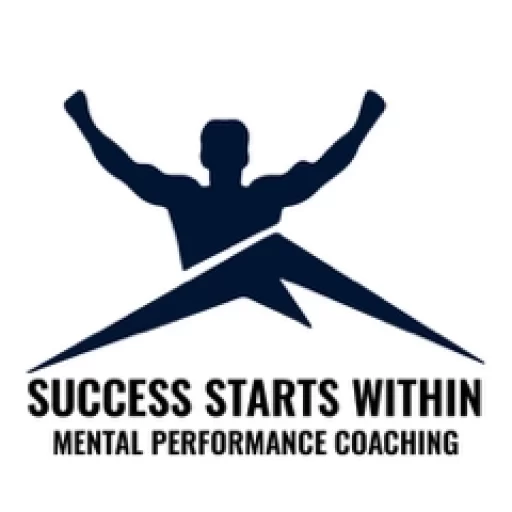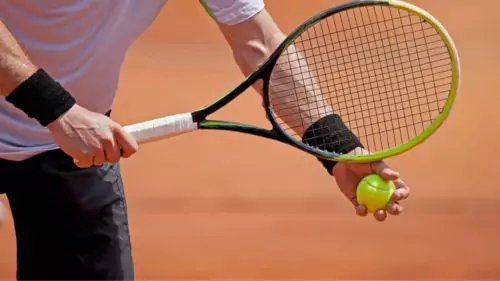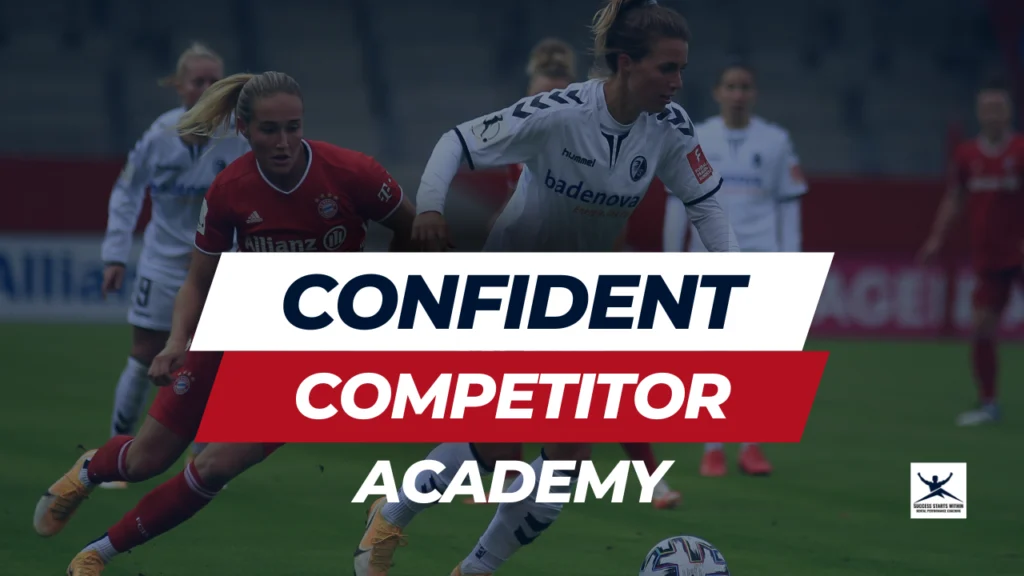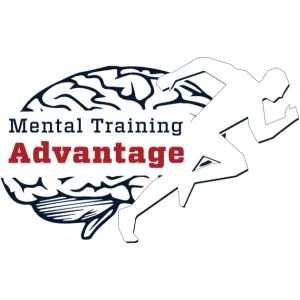When it comes to training, athletes are not at all unfamiliar with this concept. Leading into competition there are many different aspects of your game that must be trained.
What first comes to mind is the training of your physical skills. This includes working on mechanics and going over game-like situations.
Another aspect of training leading into competition is strength and conditioning. A strong and well conditioned body will grant you greater chances of success and an edge over the competition.
There is one other area, though, that is often overlooked: mental training. Combined with the previous two, when you learn how to mentally train for sports, your skills we’ll be taken to a whole new level.
What Does It Mean To Mentally Train?
Training to me equals action.
In college, I spent many hours training my skills in baseball. This looked like me performing hitting drills off the tee, taking batting practice, working on my infield skills, and throwing every day.
Everything I just described is an action.
Knowing I wanted to improve my swing, for example, meant work needed to be put forth to actively perfect my mechanics, improve my timing, along with strengthening my body so I had more power.
For you, the actions you take may be different based on your sport, but the underlying principle remains constant. To train means to put in work.
Now, when it comes to training mentally, this idea can lead to confusion. It’s easy to see how the body is put to work, but what can you do to actionably train your mind?
Well, to better understand how to train your mind, you need to think about the skills you’re seeking to develop. An easy comparison is weight training. If you want to be stronger, let’s say so you can jump higher or hit the ball further, then there are certain exercises you do to increase your strength.
The same is true with your mind. Except rather than wanting to gain strength to be able to jump higher, you’re now working to gain greater confidence or the ability to focus under pressure.
And so, just as with physical training, in order to mentally train you must take action.
Tools You Can Use To Mentally Train
To take action requires tools to do so. Within mental training there are different tools and techniques you can use depending on the skill you’re working to develop.
What you must do is decide which tools you want to use. But before choosing, you need to gain a baseline understanding as to what each of them is, the specific skills they strengthen, and how they’re performed.
Below are the most commonly used and powerful tools you can choose from to mentally train for sports:
Mental Imagery
This is one of my favorites due to the vast amount of applications there are for mental imagery. Also known as visualization and mental rehearsal, it is the practice of creating a scene in your mind.
Skills strengthened by mental imagery:
- Confidence
- Relaxation
- Ability to perform under pressure
- Skill mastery
How to perform mental imagery:
- Step 1: find a quiet location and get into a comfortable position.
- Step 2: close your eyes and breathe deeply for a couple of minutes.
- Step 3: once relaxed, go into detail on what you want to imagine. This can be a skill, a situation within a game, or a relaxing scene.
- Step 4: bring emotion into the scene.
Mindfulness
When it comes to performing well in sports competition, one of the key skills you need is the ability to control your attention. This helps with the distractions you feel along with controlling the chaos within your mind.
Mindfulness is the act of centering your attention in the present moment. It’s trained typically through meditation and is a powerful way to gain control over your attention.
Skills strengthened by mindfulness:
- Focus
- Calm mindset
- Process focus
- Emotional control
How to perform mindfulness meditation:
- Step 1: find a quiet location and get into a comfortable position.
- Step 2: set a timer.
- Step 3: close your eyes and bring your awareness to your breath.
- Step 4: when your attention drifts, quickly bring it back onto your breath.
Self-Talk
Controlling your emotions is key to success. And to control them, you must turn first to their origin: your thoughts.
Self-talk is the practice of taking control of your thoughts, reframing the way you speak to yourself in a deliberate and meaningful way.
Skills strengthened by self-talk:
- Confidence
- Focus
- Calm mindset
- Emotional control
How to perform self-talk:
- Step 1: make a list of all the negative thoughts you have.
- Step 2: create a list of positive/productive alternatives.
- Step 3: read that list to yourself twice a day every day.
Process Goals
Also known as performance objectives, process goals work by giving you something within your process to focus on. This helps to keep your attention off the outcome and unnecessary distractions during competition.
Skills strengthened by process goals:
- Focus
- Calm mindset
- Ability to perform under pressure
How to set process goals:
- Step 1: write one technical objective.
- Step 2: write one mental objective.
- Step 3: focus on these during competition.
Creating Your Own Routine To Mentally Train For Competition
When you train physically for your sport, what do you do?
You put a plan in place to build upon your strengths and work on your weaknesses. You show up each day to practice and work hard. You watch film and study your game. All of this happens out of routine.
It is simply what you do as an athlete.
When it comes to training mentally for competition, you want to take the same approach. That’s why I believe so heavily in crafting your own mental training routine.
In doing so, you make the practice of training mentally a habit. Resulting in consistent effort, leading to more consistent performances.
“When it comes to training mentally for competition, you want to take the same approach. That’s why I believe so heavily in crafting your own mental training routine.”
Step #1: Identify Your Strengths & Weaknesses
The first step is a self-evaluation practice.
Before you can create a routine for yourself, you need to know the tools to use. However, until you know what skills you wish to improve, you won’t know the best tools to focus on. And so, we begin by outlining your strengths and weaknesses.
Think about this in terms of your mental game, though, it should also drift into your physical skills as well. After all, they are deeply connected.
Here’s a sample list of strengths and weaknesses to help you when crafting your own. I will leave it broad and not sport specific, but for yourself, get very detailed in terms of the actions and skills you are performing:
My Strengths:
- Playing well early in the game.
- Focusing during practice.
- Believing I have the skills to succeed.
- Speaking highly to myself before a game.
My Weaknesses:
- Performing under pressure.
- Staying calm after a mistake.
- Not seeing myself as successful.
- Tearing myself down after a mistake.
List out your strengths and weaknesses in two columns. Take your time and really put some thought into this. It’s an incredible self-awareness activity that will provide you with insight into yourself and your game you may not be aware of.
Step #2: Decide On Your Performance Mindset
Once you outline your strengths and weaknesses, it’s now time to decide upon what mindset you want while performing. If you’ve never done something like this, it’s going to be quite a fun exercise.
It’s easy to slip into the thinking that your mindset happens to you. You show up to the field or court hoping to feel confident and hoping to feel relaxed. What you realize, however, is that your mindset is within your control.
All you must do is choose what you want it to look like.
After identifying what your performance mindset is, you can then choose tools and techniques that will work to get you into that mindset, consistently, heading into competition.
Okay, so what you want to do is take some time and think about your best three previous performances. Just pause for a moment and think about them. Once they’re in your head, begin outlining what your mindset was like during those performances.
What were you thinking? How were you feeling? Answer both of these questions in detail and to the best of your memory.
Now, look over your answers. Do you see any commonalities between the performances?
What you’re going to do now is craft a single sentence that demonstrates your performance mindset. Here are a few examples of what this will look like:
- My performance mindset is being relaxed and having fun.
- My performance mindset is feeling focused and wanting to prove myself.
- My performance mindset is feeling confident and knowing I’m going to win.
- My performance mindset is feeling calm and focused.
So now, take some time, and craft your own statement defining your performance mindset.
“It’s easy to slip into the thinking that your mindset happens to you. You show up to the field or court hoping to feel confident and hoping to feel relaxed. What you realize, however, is that your mindset is within your control.”
Step #3: Pick Your Tools
After you’ve uncovered your strengths and weaknesses and identified your performance mindset, it’s time to decide which tools you want to use.
Now, there are only four that I’ve outlined earlier, so it may seem simple enough to just choose all four. However, within each of the tools, there are many different approaches you can take.
For example if you identified that one of your weaknesses is beginning a game overly anxious, then I would suggest choosing to train mindfulness, along with performing a mental imagery exercise for relaxation.
With anxiety, the aim is to calm your mind. Mindfulness works well at reducing the amount of racing and seemingly uncontrollable thoughts you have before competition, while visualizing a relaxing scene works to recreate the calm you feel in that environment.
Another example would be if you learned that you doubt yourself a lot during games. Confidence should be your main focus, along with altering your self-belief.
The tools I would recommend are self-talk and mental imagery for confidence. The self-talk works to reprogram your mind, completely altering the deep seeded beliefs you hold towards yourself.
While the mental imagery allows you to train in your mind the memory of seeing yourself succeed.
A third example is if you struggle to perform under pressure. Now pressure is an interesting thing, in that, it’s not all together real. It’s a way of perceiving a situation which leads to you feeling more stress and pressure to perform well.
For you, I would recommend using a mental imagery exercise to perform better under pressure, coupled with process goals.
For the mental imagery exercise, imagine yourself in that pressure filled situation. Feel the anxiety, self-doubt, and whatever else you experience in that moment. Then, switch that to feeling confident and see yourself succeed.
For the process goals, you want to set your objectives before the game and then remind yourself of them when feeling pressure. That way, you approach the stressful situation the same as you do any other.
So, take your time, think it through, and choose specifically which tools you wish to use.
“With anxiety, the aim is to calm your mind. Mindfulness works well at reducing the amount of racing and seemingly uncontrollable thoughts you have before competition, while visualizing a relaxing scene works to recreate the calm you feel in that environment.”
Step #4: Created Your Routine
The final step is to take the tools you’ve chosen and piece them together into a routine.
One of the main keys I believe to change in anything is repetition. You have to be sure you are putting in consistent effort if you want to improve.
Mental training requires a routine.
This comes in two forms: your daily routine and your pregame routine.
For your daily routine, choose a time during the day (I recommend either the morning or night) to perform your mental training. Decide on how much time you’ll give, and commit to doing so consistently.
With your pregame routine, choose which tools you want to use right before competition to help get yourself into your performance mindset.
It doesn’t matter which tools you use, the same concept applies: consistent repetition is the key to mentally training for sports.
Final Thoughts
You’re all too familiar with training your physical body. It is a key component to success as an athlete. However, in addition to training physically, you must also train mentally.
When you are beginning with mental training, there is a simple process to follow. First you must identify your strengths and weaknesses. Next, craft your performance mindset. Third, choose which mental training tools you’ll use. And lastly, create your own routine.
Going through this process, putting a well thought out routine in place, will allow you to mentally train for sports and gain an edge over the competition.
Now, if you’re looking for an advanced way to mentally train for sports performance, then you need 1-1 mental game coaching. This twelve week program will begin with a mental game assessment, after which we create a custom mental game plan.
Then, we will have weekly coaching calls which include action steps for you to perform throughout the week. If you’re ready to take your mental training to the next level, click here to get started with 1-1 mental game coaching.
Thank you for reading and I wish you the best of success in all that you do.





